News
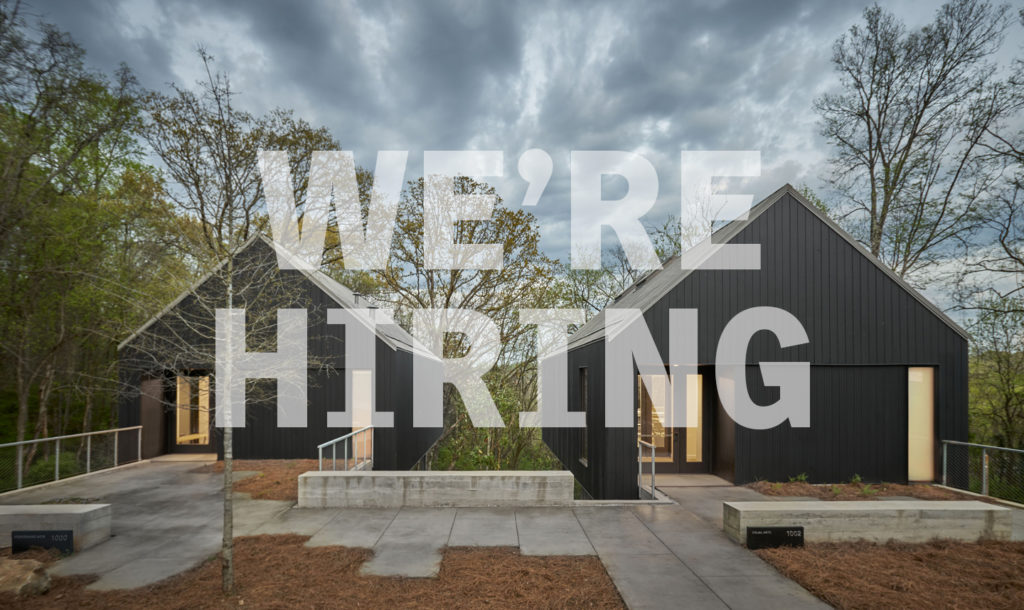
Sanders Pace Architecture is seeking talented candidates to fill two positions at the firm.
JOB POSITION: Project Architect
Sanders Pace Architecture is seeking a Project Architect to joins its team in Knoxville, TN.
Sanders Pace Architecture is an 11-person architecture practice working on a range of project types in East Tennessee. Led by John Sanders, FAIA, and Brandon Pace, FAIA, the practice initially focused on unique adaptive reuse and renovation projects in the central core of Knoxville. Sanders Pace Architecture has grown to include small-scale custom residential work, innovative institutional buildings, and large-scale public-sector projects that integrate research into a collaborative design process which leads to unique and inventive solutions. With over 100 planning, preservation, and design awards received among other accolades, Sanders Pace Architecture has established itself as one of the most thoughtful and imaginative firms practicing in the Southeast, most recently receiving a 2021 AIA Architecture Award for the Loghaven Artist Residency. Learn more about us at www.sanderspace.com.
We are looking for an experienced and talented Project Architect who is comfortable working in a fast-paced studio environment who enjoys working collaboratively as part of a team. Applicants must possess the curiosity and critical thinking skills needed to explore unique design solutions at all scales. Candidates should have a strong design portfolio, the ability to lead the production of design and construction documents, coordinate the work of consultant teams, and demonstrate strong communication skills. Sanders Pace Architecture focuses on unique, challenging, and custom design solutions ranging from small installations to public infrastructure.
Description:
Develops solutions and creates project designs and plans. Initiates and creates project designs and plans of all phases of one or more projects and has responsibility for leading the development of presentation and design drawings. Coordinates all trades and agencies related to building design while monitoring drawings. Serves as primary client point of contact and actively manages project budgets, schedules, and project team assignments.
Responsibilities:
- Initiate and lead the development of project designs.
- Coordinate and manage design efforts with the internal team and project consultants.
- Monitor and contribute to the development of project deliverables.
- Manage project budgets, schedules, and project team assignments.
Qualifications:
- Bachelors and/or Masters in Architecture from an accredited university.
- 7+ years of professional work experience. Experience should include all phases of design.
- Active professional licensure preferred.
- Well organized, with strong verbal communication skills, including experience communicating with clients and consultant teams.
- Exceptional design portfolio, with demonstrated ability to ensure delivery of design intent.
- Detail oriented with a working understanding of materials, technical detailing, and building systems.
- Strong leadership skills with the ability to manage and prioritize multiple projects.
- Proficiency is required in Revit, AutoCAD, Adobe Creative Suite, Microsoft Office, and 3D modeling software. Proficiency in Rhino and V-Ray is preferred.
Benefits:
- Salary is commensurate with experience.
- Health and vision insurance.
- Matching SIMPLE IRA contributions.
- Professional development stipend.
- Opportunities for growth.
Sanders Pace Architecture is an equal opportunity employer.
Correspondence via email only: Please submit a resume and digital portfolio (PDF Format < 10MB) to info@sanderspace.com. No calls, please.
JOB POSITION: Project Designer
Sanders Pace Architecture is seeking a Project Designer to joins its team in Knoxville, TN.
Sanders Pace Architecture is an 11-person architecture practice working on a range of project types in East Tennessee. Led by John Sanders, FAIA, and Brandon Pace, FAIA, the practice initially focused on unique adaptive reuse and renovation projects in the central core of Knoxville. Sanders Pace Architecture has grown to include small-scale custom residential work, innovative institutional buildings, and large-scale public-sector projects that integrate research into a collaborative design process which leads to unique and inventive solutions. With over 100 planning, preservation, and design awards received among other accolades, Sanders Pace Architecture has established itself as one of the most thoughtful and imaginative firms practicing in the Southeast, most recently receiving a 2021 AIA Architecture Award for the Loghaven Artist Residency. Learn more about us at www.sanderspace.com.
We are looking for an experienced and talented Project Designer who is comfortable working in a fast-paced studio environment who enjoys working collaboratively as part of a team. Applicants must possess the curiosity and critical thinking skills needed to explore unique design solutions at all scales. Candidates should desire a creative workplace and be motivated to pursue professional growth within the practice. Sanders Pace Architecture focuses on unique, challenging, and custom design solutions ranging from small installations to public infrastructure.
Description:
Works with Project Architect and Principal to develop creative-design concepts for projects, coordinates project design, and prepares presentation and design drawings.
Responsibilities:
- Actively support and contribute to the development of project designs.
- Execute exceptional presentation deliverables within tight schedules.
- Develop design drawings and construction documents.
- Continued project involvement through all phases of design, including construction administration.
Qualifications:
- Bachelors and/or Masters in Architecture from an accredited university.
- 3+ years of professional work experience. Experience should include all phases of design.
- Well organized, with strong verbal communication skills.
- Exceptional conceptual design and critical thinking skills, represented through examples of past work.
- Confidence in expanding on information provided by others through exploration of iterative solutions.
- Working knowledge of design trends and materials.
- A passion for researching unique materials, assemblies, and processes.
- Proficiency is required in Revit, AutoCAD, Adobe Creative Suite, Microsoft Office, and 3D modeling software. Proficiency in Rhino and V-Ray is preferred.
Benefits:
- Salary is commensurate with experience.
- Health and vision insurance.
- Matching SIMPLE IRA contributions.
- Professional development stipend.
- Opportunities for growth.
Sanders Pace Architecture is an equal opportunity employer.
Correspondence via email only: Please submit a resume and digital portfolio (PDF Format < 10MB) to info@sanderspace.com. No calls, please.
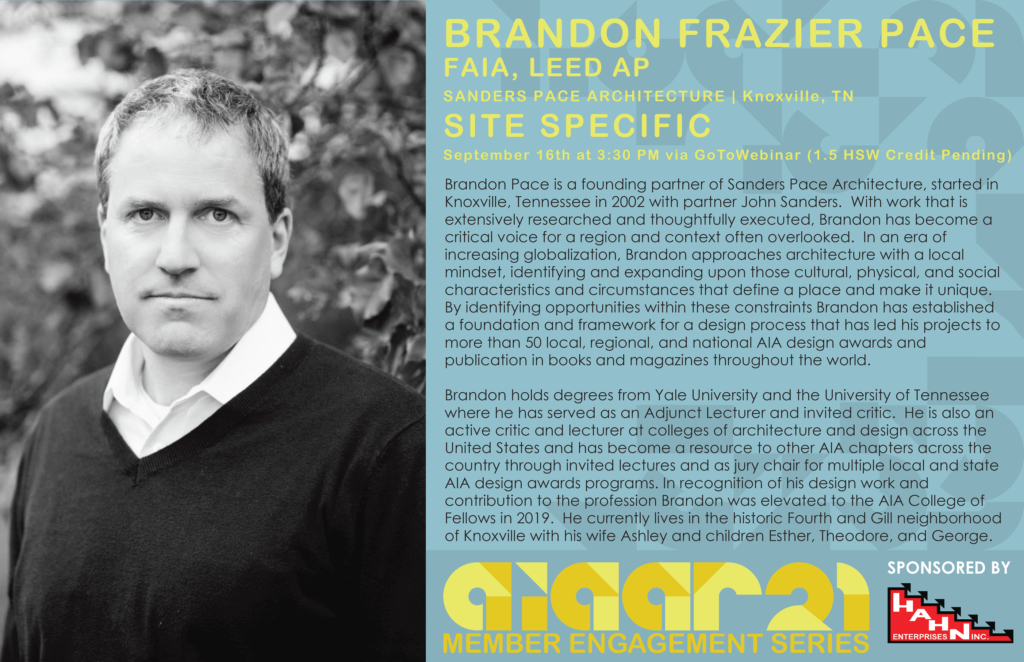
The talk will focus on stories of Knoxville’s past, present, and future through a series of projects that illustrate how local conditions and circumstances inform the Firm’s design process. The talk will include a cross-section of work that varies in type and scale within a context that stretches across the Tennessee Valley from Knoxville’s urban neighborhoods to the edge of the Cumberland Plateau and the Great Smoky Mountains.
This lecture is free and open to the public, a link to register can be found HERE.
French Broad House featured in Residential Design Magazine
Residential Architect Magazine included a feature on Sanders Pace Architecture’s French Broad House as part of their “Quiet Time” feature in the most recent issue of the magazine.
Check out the article HERE.
Oxford American Magazine features work of Southern firms as part of it’s Summer 2021 Place Issue.
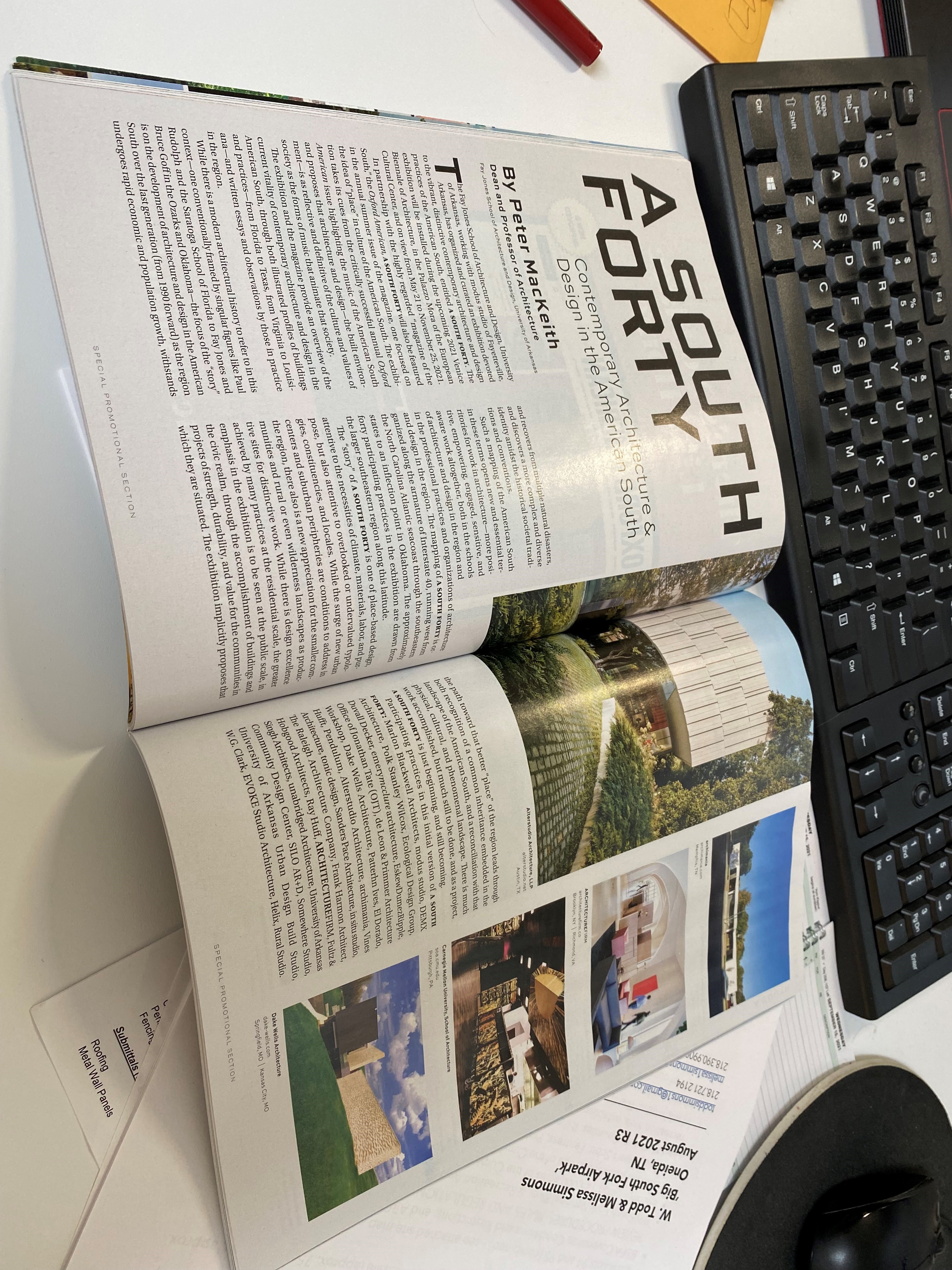
Peter MacKeith, Dean and Professor of Architecture at the University of Arkansas contributed a piece called A South Forty, Contemporary Architecture and Design in the American South. Sanders Pace Architecture is proud to be a part of this group, currently on exhibition in Venice at the Palazzo Mora. The exhibition will run through November 30, 2021.

Tracy Haun Owens with local journal Hellbender Press was on-site at Loghaven recently exploring the campus grounds and conducting interviews in advance of the next Residency which starts on July 12th. The article speaks to the importance of Loghaven’s place within the Urban Wilderness and the Aslan Foundation’s commitment to preservation within our community. Read the full article HERE.
Loghaven Artist Residency featured in Dezeen
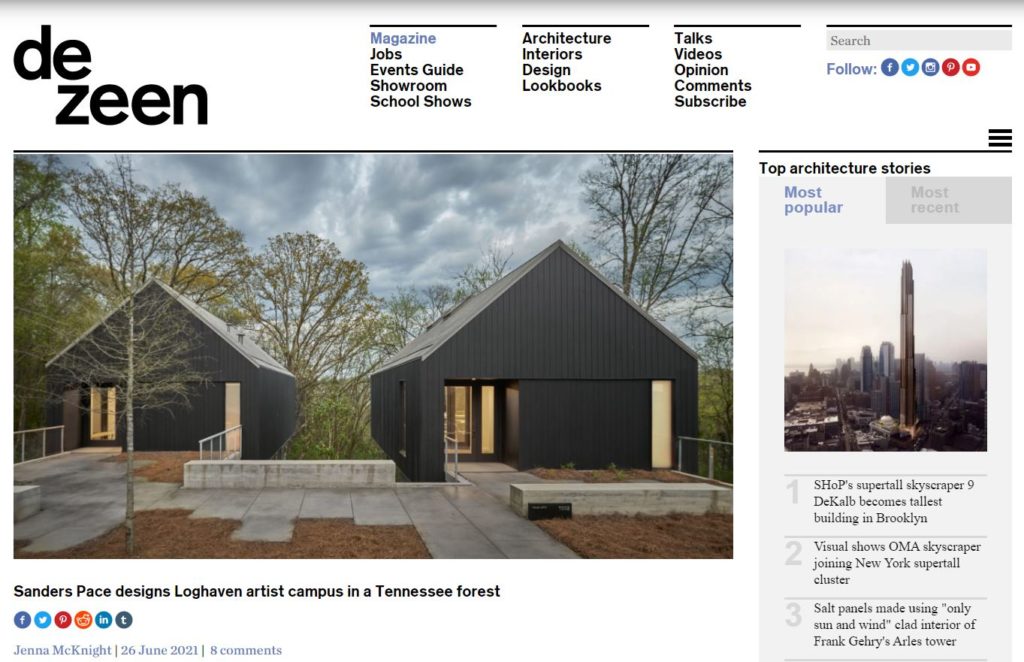
The Loghaven Artist Residency was the subject of a feature on the Art and Design journal Dezeen recently. In the article, contributor Jenna McKnight highlights the firm’s design work on the campus which was recently the recipient of an AIA National Honor Award. Click HERE to read the article.
We are honored to be a part of A South Forty, an exhibition to demonstrate the vitality of contemporary architecture and design in the American South through the work of multiple practices across the region.
The exhibition is on display at this year’s Venice Biennale, running from May 22-November 21 at the European Cultural Centre located in the Palazzo Mora in Venice.
Thanks to Peter MacKeith and Jonathan Boelkins at the University of Arkansas Fay Jones School of Architecture and Design, Modus Studio, and Oxford American for putting this together! Full press release below.
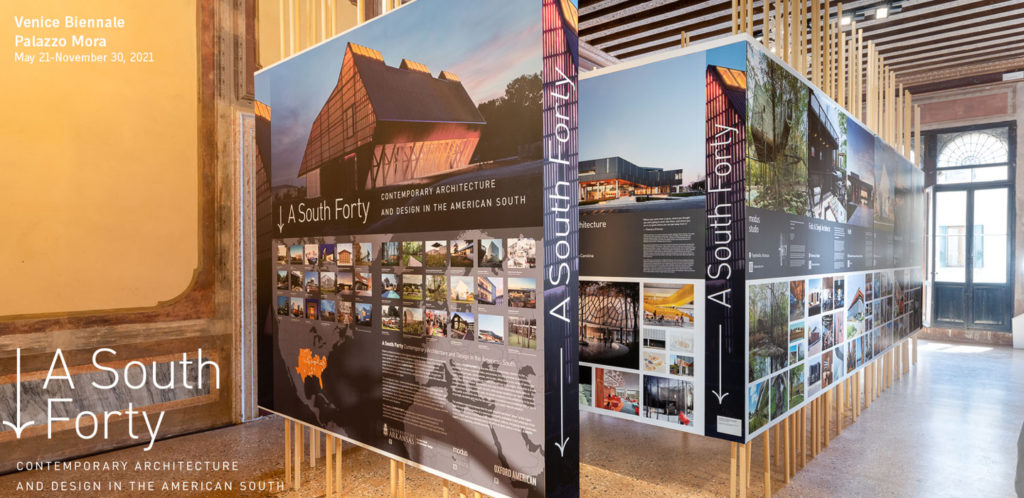
VENICE, ITALY – As part of the “TIME SPACE EXISTENCE” exhibition for the 2021 Venice Architecture
Biennale, The European Cultural Center will present A South Forty: Contemporary Architecture and Design
in the American South at Palazzo Mora. A South Forty is organized by the Fay Jones School of Architecture
and Design, University of Arkansas, together with modus studio of Fayetteville, Arkansas, and the Oxford
American Journal, and highlights the work of nearly forty practices. The exhibition is installed in the Great
Hall facing the canal and will be open from May 22nd through November 21st, 2021, with a press preview
on May 20th.
Exhibition Summary: The Fay Jones School of Architecture, University of Arkansas, working with modus studio
of Fayetteville, Arkansas, has worked to organize and curate an exhibition devoted to the vibrant, distinctive
contemporary architecture and design practices of the American South. The exhibition is aimed for installation
during the upcoming 2021 Venice Architecture Biennale, in a collateral venue, the Palazzo Mora of the
European Cultural Center.
In partnership with the highly regarded literary journal of the American South, The Oxford American, A SOUTH
FORTY will also be featured in the annual summer issue of the journal, one focused on the idea of “place” in
culture of the American South. The exhibition takes its cues from the critically successful and popularly
appealing annual Oxford-American issue highlighting the music of the American South and proposes that
architecture and design – the built environment – is as reflective and definitive of the culture and values of
society as the forms of music that animate that society.
Modern architectural history in the regional context of the American South is conventionally framed by
singular figures, from Paul Rudolph and the Saratoga School of Florida to Fay Jones and Bruce Goff in the
Ozarks and Oklahoma, or stereotypical typologies and appearances. In counterpoint, A SOUTH FORTY aims to
provide an overview of the current vitality of contemporary architecture and design in the American South,
through both illustrated profiles of buildings and practices, and statements of principles and observations by
those in practice in the region.
The contemporary “story” centers on the development of architecture and design in the American South
over the last generation (from 1990 forward) as the region undergoes rapid economic and population
growth, it stands and recovers from multiple natural disasters, and discovers a more complex and diverse
identity amidst the historical societal traditions and conventions. Such a mapping of the American South in
these terms open new and essential territories for work in architecture – more positive, empowering,
engaged, sensitive, and aware work altogether.
The mapping of A SOUTH FORTY geographically is organized along the armature of US Highway 40, running
west from the North Carolina Atlantic seacoast through the southeastern states to an inflection point in
Oklahoma. Approximately forty participating practices in the exhibition are drawn from the larger
southeastern region along this latitude.
The “story” of A SOUTH FORTY is also one of place-based design, attentive to the necessities of climate,
materials, labor, and purpose, but also attentive to overlooked or undervalued typologies, constituencies,
and locales. While there is the surge of new urban centers and suburban peripheries as conditions to
address in the region, there also is a new appreciation for the smaller communities and rural or even
wilderness landscapes as productive sites for distinctive work. As well, while design excellence has been
achieved by many practices at the residential scale, the greater emphasis in the exhibition is to be seen at
the public scale, in the civic realm, through the accomplishment of buildings and projects of strength,
durability and value for the communities in which they are situated.
The exhibition implicitly proposes that the path towards that better “place” of the region leads through
both recognition of a common inheritance embedded in the landscape of the American South, and a
reconciliation with that physical, cultural and phenomenal landscape. There is much work accomplished,
but much still to be done, and as a project, A SOUTH FORTY is just beginning, and still becoming.
A SOUTH FORTY: Contemporary Architecture and Design in the American South features the work of:
Alterstudio; Archimania; Architecturefirm; Dake Wells architecture; de Leon & Primmer Architecture
Workshop; DEMX architecture; Duvall Decker; Ecological Design Group; El Dorado / KSU Design + Make
Studio; emerymcclure architecture; Eskew Dumez Ripple; Evoke Studio Architecture; Frank Harmon
Architect; Fultz & Singh Architects; Helix Architecture + Design; Hobgood Architects; Ray Huff Architect;
Hufft; in situ studio; Katherine Hogan Architects; Marlon Blackwell Architects; modus studio; Office Jonathan
Tate; patterhn ives; Pendulum; Polk Stanley Wilcox; Rural Studio; Sanders Pace Architecture; silo ar+d;
Somewhere Studio; The Raleigh Architecture Company; Unabridged Architecture; University of Arkansas
Community Design Center; University of Arkansas Urban Design Build Studio; Vines Architecture; W.G. Clark
Architect
KNOX HERITAGE ANNOUNCES 2021 EAST TENNESSEE PRESERVATION AWARDS
East Tennessee is a beautiful region that is rich with history and interesting places. Each year, Knox Heritage and the East Tennessee Preservation Alliance recognize outstanding persons, projects and organizations working to preserve our heritage for future generations. This year’s award winners were recognized during a virtual ceremony on May 20th.
The City of Knoxville Mayor’s Award was presented to Dover Signature Properties and BarberMcMurry Architects for the restoration of the historic South High School at 835 Tipton Avenue. Dover obtained the property in 2016 after several attempts by others to redevelop the space. It took a year to stabilize the building and two years to renovate the existing building into South High Senior Living.
The Preservation Service Award is presented to Cherel Henderson for her service as the Executive Director of the East Tennessee Historical Society (ETHS) from 2003 until 2020. Cherel joined the ETHS staff in 1987, and was promoted to associate director in 1995 and to executive director in 2003. Over the past 17 years under Cherel’s leadership, ETHS has continued to thrive and grow. Cherel is the founding director of the ETHS Tennessee Bicentennial family heritage program, First Families of Tennessee, which now numbers almost 17,000 members from all over the world. She was also editor of the book First Families of Tennessee: A Register of Early Settlers and Their Present-Day Descendants. Other highlights of her career include the 2004 completion of the East Tennessee History Center’s renovation of the Old Custom House and addition that houses the Museum of East Tennessee History. She also oversaw design and construction of the Museum’s signature exhibition, Voices of the Land, The People of East Tennessee, that opened in 2008.
Knoxville History Project was presented with the Media Award for the recently published Historic Bearden: The 200-Year Story of Knoxville’s Fourth Creek Valley. The 200-page, full-color guidebook written by Jack Neely, edited and image sourced by Paul James and designed by the awarding winning team at Robin Easter Design is a great way to learn more about local history.
Additional award winners include: Reagan Design + Construction and Dgray & Hbogus, LLC for the renovation of 2545 Jefferson Avenue in the Parkridge neighborhood; the City of Knoxville for renovating the Jackson Avenue Ramps; Parkridge Group, LLC and Sanders Pace Architecture for the renovation of 1520 Washington Avenue in the Parkridge neighborhood; Holli McCray and John Verdeaux for the restoration of the 1940 Annandale Manor; The Aslan Foundation and Sanders Pace Architecture for the restoration of seven historic cabins and construction of new structures associated with the newly established Loghaven Artist Residency; Arin Streeter for writing the National Register nomination for the Charles L. Lawhon House in the Morningside neighborhood; Segal Drummond and Sanders Pace Architecture for the renovation of 517 and 519 N. Central Street in the Emory Place Historic District; Axle Logistics and Design Innovation Architects for the renovation of the former Hull and Dobbs building located at 835 N. Central Street; The Aslan Foundation and Sanders Pace Architecture for the restoration of the Candoro Marble Building in the Vestal community; ELST Brewing Company and Sanders Pace Architecture for renovating and adapting two dilapidated 80 year old buildings into a new craft brewery and community gathering space within the Oakwood-Lincoln Park neighborhood; Jim and Lori Klonaris, SK Ballard Contract Interiors and Johnson Architecture, Inc for the renovation and adapted reuse of two floors in the Holston Building into the high-end restaurant and retro cocktail bar, Vida and The Vault; John Sanders for the restoration of Clauss House II located in the Little Switzerland neighborhood; and Sanders Pace Architecture for the renovation of 509 N. Central Street in the Emory Place Historic District.
In addition, the East Tennessee Preservation Alliance presented regional preservation awards to the Claiborne County Historical Society for grant-related repairs to the 1819 Old Claiborne County Jail in Tazewell; KBD, LLC and Brewer Ingram Fuller Architects, Inc for the renovation of the 1907 Building into a brewery, restaurant and event space located in downtown Morristown; Dean and Karen Fontaine for placing Millennium Manor in Alcoa on the National Register of Historic Places; and the Dunbar Rosenwald School Foundation, Inc and Brewer Ingram Fuller Architects, Inc for the restoration of the Dunbar Rosenwald School in Loudon.
Loghaven Artist Residency featured in the Knoxville News Sentinel.
See inside Loghaven, South Knoxville artists’ retreat that won top architectural prize
Ali JamesShopper News
Knoxville-based Sanders Pace Architecture will receive the 2021 American Institute of Architects’ Architecture Award for its design of the 90-acre Loghaven Artist Residency campus, a secluded site of historic log cabins and deep woods in South Knoxville.
It is the highest honor for architecture in the nation, and only one other building in Tennessee ever has won the award, which celebrates the best contemporary architecture — no matter the budget, size, style or type.
Sanders Pace worked alongside the Aslan Foundation, which funded the project, during a six-year planning and design process.
“I don’t think people realize how important the award is,” said Andrea Bailey, Aslan Foundation executive director. “During the history of the award there has only been one other building in all of Tennessee that has won it.”
One of the things that stood out for the campus as a whole is the way the buildings interact with nature and with each other, Aslan Foundation officials told the AIA committee.
“There is this unfolding from one space to the next, the way the studio is perched on a hillside — this old and new — to me, it’s the full package,” Bailey said.
More:Once threatened by developers, South Knoxville’s saved Loghaven becomes artists retreat
More:Want out of the house? Explore South Knoxville history on a driving tour
Artists from across the country — in visual art, dance, music, writing, theater and interdisciplinary work — can stay there. To date, five cabins have been restored, each featuring original logs, a working fireplace, a porch, artist working space and modernized kitchens and bathrooms.

A visual arts studio and performing arts studio are cantilevered structures that extend into the tree canopy and capture views through 8-foot windows.
“The idea is to give the artists an opportunity to get away from their 9-to-5 jobs and focus on their art,” Bailey said. “They not only have the time and resources, but the appropriate studio space.”
Building named for Jim McDonough
Aslan Foundation director and retired architect Jim McDonough died March 6, and to honor his life, the 3,900-square-foot central building was named the McDonough House.
The building serves as the operations center for the residency and is a small multi-disciplinary venue that can accommodate small performances and space and equipment for up to five artists to collaborate.
“There is a kitchen, living and dining room where the artists can come and gather,” Bailey said. “That was important to Jim; I don’t think this project would have happened without him, and it is an important way to honor him.”

McDonough mentioned Loghaven to Sanders Pace Architecture while discussing the 600-acre plan for the Battlefield Loop in 2014.
“I had never heard of it before,” founding partner Brandon Pace said. “Loghaven is in the center of the Battlefield Loop, and there were old cabins that they were looking to restore. And we were hired to make them safe and comfortable.” The project soon expanded beyond rehabilitation.
Pace said that they saw the project as a conversation across eras. “The first era was the development of Native American settlements; the first modern era was Myssie Thompson in the 1930s.”
(To support her family during the Great Depression, Martha “Myssie” Thompson built a nest of rental cabins on the ridgetop she called “the hill.”)
“I said that the next phase should not just be a replication of Myssie Thompson’s era,” Pace said.
Connecting new, historic and natural
“The historic cabins all have a stone base, the same metal roofs; four have round logs, one with hewn logs,” Pace said of the design. “We took that material language and how they related to the site and made everything a little more refined. The buildings are built to meet current energy goals and are heavily insulated with lots of references back to the original structures.”
McDonough was really the design champion, Pace said. “During the process he challenged us not to leave anything unconsidered,” he said. “It is a dream project and a dream client. As a student you never think you’ll get to do this as a professional.”

Michael Davis is a project architect and a lead designer at Sanders Pace Architecture; he’s been involved since the first site work in 2014.
“We looked at the cabins and wondered what the heck we were going to do?” Pace said. “He was the project manager on the digital and performing arts studios, the first phase of the five cabins and the McDonough House.” Davis has just received a Young Architect award as well.
“Lindsay McDonough (Aslan Foundation Board Member) kept saying it’s about the place, not a single building,” Pace said. “She wanted to preserve the character, the trees and the experience of walking down Loghaven drive.”

Sanders Pace removed the ill-conceived additions — decks that were not in keeping with what Myssie Thompson would have done. “She built the cabins some 80 years ago; a lot of the things were structural interventions,” Pace said.
The history of Loghaven is captivating.
“Myssie Thompson did something that would be unusual in this day, much less building a rental community of log cabins during the Great Depression,” Bailey said. “She was a single mother and took part in building some of the cabins herself. She built them with her contractor as she had the funds. She oversaw the rentals until she was about 80.
“The character was there, we just wanted to make sure that character lasts.”

The Loghaven Artists Residency, opened in January 2020, will launch an open call for applications on June 1. Submissions will be accepted from emerging and established artists across the U.S., ages 21 and up.
Free tours of the indoor and outdoor artists spaces will be given at 5:30 p.m. May 13 and May 20 or 9:30 a.m. June 9. Masks and registration required: eventbrite.com/e/loghaven-spring-tours-tickets-153036882435.
More details about the artist residency criteria at loghaven.org/residencies/apply.
Funding for Phase 2 of Augusta Quarry included Mayor’s 2021-2022 Budget
The Shopper News ran an article on May 3 talking about improvements at the South Knoxville site at the center of the Battlefield Loop.
$1 million plan to enhance Augusta Quarry recreation
Ali James, Shopper News
It may not officially be swimming season, but a handful of Augusta Quarry visitors were making the most of the warmer temperatures recently.
When Sheryl Ely, Knoxville Parks and Recreation director, asked two of them how they enjoyed their swim, they laughed and admitted to lasting barely a minute in the icy, deep water. Others were not deterred as they floated in their inflatable rings before the thunderstorms rolled in.
“I was here the other day and I saw lots of out-of-state license plates in the parking lot, including a family from Florida, and someone had strung up a hammock between the trees,” said Ely.
$1 million for Urban Wilderness site
On April 27, Knoxville Mayor Indya Kincannon proposed her 2021-22 budget, and there was one line item that was exciting news for Urban Wilderness enthusiasts. One million dollars has been allocated for phase two of the Augusta Quarry project .
Funding will be used for improving accessibility and safety to the quarry, as well as adding a vendor area and restrooms.
Ely and city Greenways Coordinator Tim Hester met the Shopper News in the parking lot, completed as part of phase one in the fall of 2019.
“People probably won’t see the beginning as it is the infrastructure — water and electricity improvements,” said Ely. “We will also be finding contractors, arranging purchasing and figuring out how we will finalize our plans.”
While Ely did not want to promise a firm start date for the project, she and Hester agreed that design work will really start later in the year.
Kayaks, boardwalk and swimming area
With mostly native landscaping and a formalized park entry and parking area established during phase one, most of the attention will now focus on the water’s edge in this next phase.https://53e3519dac4b58c6f3e3696e76e12369.safeframe.googlesyndication.com/safeframe/1-0-38/html/container.html
PORT and Sanders Pace Architecture worked with the City of Knoxville and Aslan Foundation to design phase one, and Ely pointed out how the design for Phase 2 will fit into the natural surroundings.
“We will not have the dock, but a boardwalk for people wanting to get closer to the water,” she said.
A more defined swimming area will be addressed this summer, including buoys, boulders and clear, consistent signage. Since the limestone quarry closed 30-40 years ago, the city has taken steps to deter people from diving off the 100-foot-high rocks by adding signage and fencing. Ely and Hester hope a better defined swimming area will further promote safety.
Ely gestured to the space between the gravel road leading to the water and the craggy rocks that have been designated for a vendor.
“We want them to set up here where it’s easy access to the water for rental equipment,” she said. “We are looking at different kinds of vendors, similar to what Mead’s Quarry has.”
Hester said they are looking for a business to hire out kayaks and tubes, and not a food truck or T-shirt vendor, and they hope to have that vendor in place for the summer. That season will officially kick off on Memorial Day and run through Labor Day.
“Parks and recreation staff will be here regularly over the summer, as well as KPD officers to make sure everyone is being safe,” said Ely. “We still recommend people use personal protective devices for swimming — it is open water, like the Tennessee River, and we want them to remain mindful of that.”
“Over the years we have expanded the recreational opportunities for mountain bikers, hikers, and birdwatchers,” said Hester. “That activity and the upgrades — the new entrance and trail — tend to keep other (destructive) activity away.”
“The Aslan Foundation played a big part in partnering with us in phase one; they love this design for phase two,” added Ely.